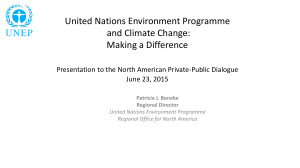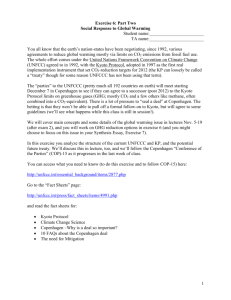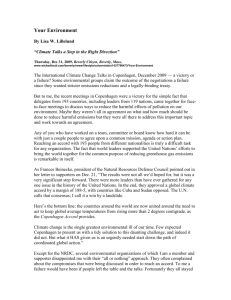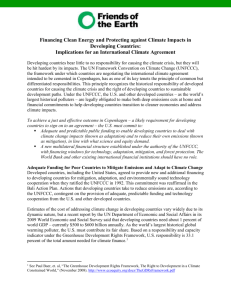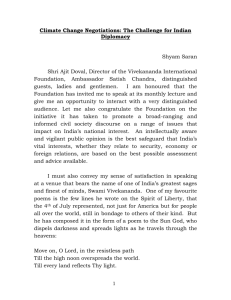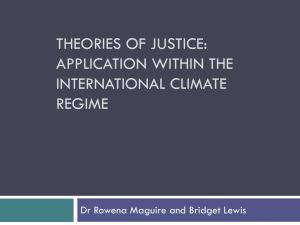What happened in Copenhagen and where to next?
advertisement
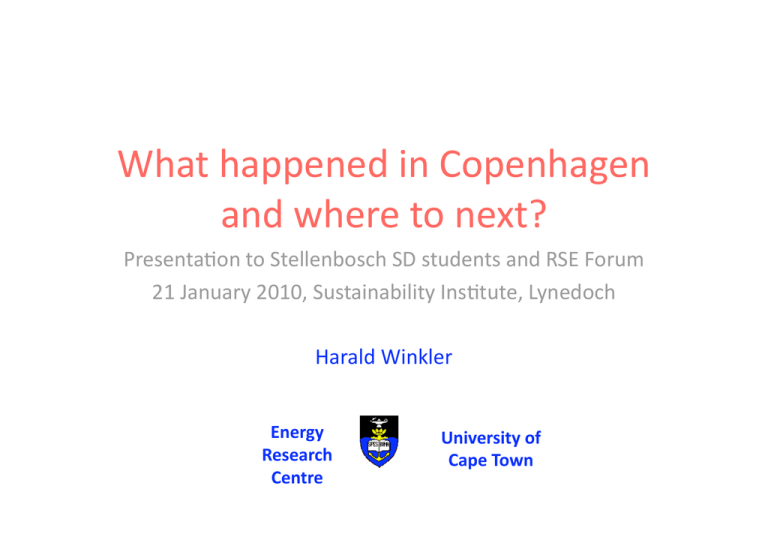
What happened in Copenhagen and where to next? Presenta4on to Stellenbosch SD students and RSE Forum 21 January 2010, Sustainability Ins4tute, Lynedoch Harald Winkler Energy Research Centre University of Cape Town ? What happened in Copenhagen? Copenhagen Accord – what was agreed WHAT WAS AGREED • 2°C goal (but pledges add up to more than 3 °C; does not state pre‐industrial levels • Bringing the US in: economy‐wide binding emission reduc4on targets, no4fy by 31 January 2010 – how to bring in: schedule of ‘targets’ • Mi4ga4on ac4ons by the more advanced developing countries, also by 31st January 2010 – bring in schedule of ac4ons and mechanism to register • Measure report and verify ‐ resolving a key dispute over review vs transparency • Finance: transparently accounted finance $10 bn per year up to 2012, i.e. approaching $30bn immediately up to 2012 and $100 billion per year by 2020 – Condi4onali4es – But all of GEF from 1994 to 2009 was $18 bn • Technology development and transfer mechanism, but cannot opera4onalise without COP decision • Review by 2015 against 1.5 ºC – if what is poli4cally agreed is not enough, need to strengthen later • Deal among key protagonists on mi4ga4on, with representa4on from regions and interests, minus one Copenhagen Accord – what was not agreed WHAT WAS NOT AGREED • No new treaty, or mandate to agree one , or con4nua4on of one we have (had?) – Kyoto • Disagreement on a comprehensive interna4onal adapta4on programme as a priority or whether it should be an adapta4on framework – and s4ll 4ed to response measures • Low level of ambi4on of developed countries targets ‐ 14‐19% below 1990 level by 2020 – And loopholes remain wide open • Pledges by developing countries, are rela4ve to business‐as‐usual (BAU) – beger, but also not enough yet – and baselines uncertain • For DCs to do more, or the finance will have to become real, uncondi4onal and interna4onally verified • Developing countries more ambi4ous then developed countries – less unambi4ous • Added up, really more than 3°C • Dropped long term target to cut emissions (the language on 50% reduc4ons by 2050 from 1990 levels – Because no agreement on equitably sharing carbon space • No agreement where money will come from • No consensus among 193 countries Formal nego4a4ng text • CA ‘noted’ in very short decision – Cannot opera4onalise Fund or Technology Mechanism • Official nego4a4ng text forwarded – L.7/Rev.1 and 9 addenda – Beger structure for developing countries – E.g. mi4ga4on: kept a clear fire‐wall between commitments by developed countries, ac4ons by developing countries – But had no agreement on finance numbers – Process: agreed by all, more protec4on for smaller countries • Also forwarded nego4a4ng text for KP – S4ll alive, but in ‘intensive care’ • To June nego4ators mee4ngs and COP / CMP in Mexico, December 2010 ? Assessment: was Copenhagen a failure, a founda4onal event or a greenwash? Copenhagen read in very different ways by different people Not the US response Brokenhagen,Tokenhagen or Hopenhagen? • Copenhagen was many things – but it was NOT the breakthrough the we needed – Dr Seuss: delegates and leaders “blew it” – Brokenhagen – failure – Gap between art of possible and requirements of science; not FAB; dysfunc4onal process • Some observers posi4ve on Cph Accord – US: New process, first step – Poli4cal deal unlocked some difficult issues – ALBA: victory that CA was not imposed – Hopenhagen: laid founda4on for future work • Greenwash – Tokenhagen – no legaly treaty, therefore play up poli4cal deal – Yes, but: ignores the ques4on of which is more effec4ve ? Deeper ques4ons: what happened and why? Shi8s in overall dynamics: objec?ve and subjec?ve factors • Context of objec4ve external factors – – – – Recession – implica4ons for finance increasing scarcity –food, water looming peak oil overconsump4on • Subjec4ve factors – – – – Great expecta4ons – but then lowered US not ready to nego4ate EU decision to abandon Kyoto Inept chairing by Danish PM • exclusion of the ALBA • Not pure obstruc4onism ‐ needed to demonstrate that exclusion won’t work – Lack of responsibility in engagement by some individuals in the G77 • Clearly dis4nguish this from the legi4mate concerns over process, especially by smaller developing countries Process dominates substance • Lack of poli4cal will to do the deal trumped urgency of ac4on required by science Procedural equity is cri4cal • But process can be used to block • Problems: – Process at three levels: official – Ministerial – summit • Par4es were too far apart and could not produce a text capable of poli4cal sign‐off • Poli4cal deal was disconnected from official process • Climate nego4a4ons highly complex: too poli4cal for the technicians, too technical for the poli4cians The world is changing • Geopoli4cal shiqs: Rela4ons between powers not what they were in 1992 • China as the world power in wai4ng; has financial resources, and able to nego4ate from strength; deep feeling of responsibility; not yet use to new role (in the past, much more reserved) • US seeking to assert its role as hegemon (while it lasts) and seeks to re‐write the rules; US not fully engaged in nego4a4ons, in absence of legisla4on • EU not able to lead as in the past • Strong insistence on CBDR by developing countries, despite changing reali4es and because concerns of poor and weak not properly represented • Process has not yet caught up with new dynamics • US openly cri4cising the UNFCCC, EU abandoning Kyoto ! So how do we move forward – big picture Future of UNFCCC? • UNFCCC did not deliver – lack of willingness to use every opportunity – Ban Ki‐moon’s face‐saving statement: “This accord cannot be everything that everyone hoped for, but it is an essen4al beginning,” (UNFCCC 2009) • Will the UNFCCC become a permanent nego4a4ng forum, – a la WTO? (and as ‘successful’); – Or a talk‐shop, a la CSD ? – Or all done in G20 • Trend to work in smaller for a (N‐20 disarmament; C‐29 climate; G20 finance and all, as long as you don’t touch the P‐5 global security) • Will climate ac4on be driven by na4onal poli4cs, “in conformity with domes4c law” (US line) • Challenge is to bring poli4cal deal reflected in Cph Accord back into the official UNFCCC text Future of groupings • Played old games – fights between extremes – OPEC failure is success – AOSIS hard line: 1.5ºC and 350 ppmv; legal treaty • More asser4ve and new groupings – – – – Africa pushed hard for Kyoto LDCs were more vocal BASIC since 2008, but more prominent, esp on deal on MRV with US Members of ALBA: • Leq‐leaning La4n Americans (with some OPEC) • ‘rights of Mother Earth’, climate jus4ce • procedurally correct • Some commentators predict end of G77, shiq to new alliances – “the G‐77 may be spent as a unified force” (Doniger 2009) – “groupings such as the G77/China which are now dysfunc4onal and anachronis4c” (Mehra 2009) • New alliances between some DCs and EU? – BUT small countrise will con4nue to seek protec4on in unity (esp on adapta4on) – G77 will need to find ways of becoming more effec4ve • Ul4mately, poor countries and communi4es most at risk from the impacts of climate change Where will climate ac4on be done? Scenarios of different fora: • End of UNFCCC • Cling to UNFCCC at all costs • Smaller groups: Shiq to G20 / MEF • Fragmented mul4‐lateralism: A and M in different fora • Fragmenta4on: No global process, domes4c law • S4ck with UNFCCC • Permanent nego4a4on / talk shop (WTO / CSD) • Not by goverments at all: People’s Summit What if there were NO global agreement? – Does the movement for global jus4ce have within it the basis for global democracy? – Can we count on business? – If na4on‐states fail to agree, are other forms of ac4on effec4ve? – How could we design a mul4‐lateralism that is more effec4ve and mature (in the way in which we nego4ate, e.g. showing restraint and seriousness about substance)? How can we do that while remaining inclusive? ? Since Copenhagen AI submissions by 31 January 2010 • US: “emissions reduction target” of 17% below 2005 levels by 2020 – As little as 2% below 1990 levels – conditional on others notifying – “in conformity with anticipated US energy and climate legislation” – will Obama spend political capital on climate • Canada – "17%, to be aligned with the final economy-wide emissions target of the United States in enacted legislation." • Annex I in aggregate 14-19% below 1990 levels by 2020, well below range of 25-40% Developing countries: less unambitious • China: reduce carbon dioxide emissions per unit of GDP by 40 to 45 percent by 2020 – In climate plan, aligned with 5-yr plan • India: reduce emissions intensit of GDP by 20 to 25% by 2020 • Brazil 36% plus NAMAs, mainly avoided deforestation in Amazon • SA numbers as announced by the Presidency before Copenhagen, now internationalised • Several others Which is more likely to happen • – the US target or China’s actions on intensity? My bets are on China – what is planned will get done. If the US passes its law, that will also be given effect – but that’s still a big if. SA’s NAMA – 31 Jan 2010 • “The commitment of South Africa to play its part to address climate change has already been reflected in President Zuma’s announcement made on the 6th of December 2009. South Africa has conducted an interna4onally reviewed study of its mi4ga4on poten4al in the context of long‐term mi4ga4on scenarios, which has informed the na4onally appropriate mi4ga4on ac4on that may be taken. In accordance with the provisions of Ar4cle 12 paragraph 1(b) as well as Ar4cle 12 paragraph 4 and pursuant to the provisions of Ar4cle 4 paragraph 1 of the Conven4on, South Africa reiterates that it will take na4onally appropriate mi4ga4on ac4on to enable a 34% devia4on below the ‘Business As Usual’ emissions growth trajectory by 2020 and a 42% devia4on below the ‘Business As Usual’ emissions growth trajectory by 2025. In accordance with Ar4cle 4.7 of the Conven4on, the extent to which this ac4on will be implemented depends on the provision of financial resources, the transfer of technology and capacity building support by developed countries. Therefore, the above ac4on requires the finalisa4on of an ambi4ous, fair, effec4ve and binding mul4lateral agreement under the UNFCCC and its’ Kyoto Protocol at COP 16 and CMP 6 in Mexico to enable the delivery of this support. With financial, technology and capacity building support from the interna4onal community, this level of effort will enable South Africa’s green house gas emissions to peak between 2020 and 2025, plateau for approximately a decade and decline in absolute terms thereaqer.” hAp://unfccc.int/files/mee?ngs/applica?on/pdf/southafricacphaccord_app2.pdf SA numbers based on LTMS, adjusted for electricity • Long-term mitigation scenarios (LTMS): peak, plateau and decline agreed by Cabinet mid-2008 • Now ‘internationalised’ by Zuma Presidency • LTMS numbers formed basis of calculating ‘deviation below BAU’ – Based on rigorous modeling combined with strategic stakeholder inputs – Adjusted for near-term electricity plans • Even with adjustments, possible to slow the growth of emissions significantly – if take aggressive action elsewhere Association • Not all countries men4on Accord • Developing countries not used format of table • Storm in a tea‐cup – Substan4vely associa4ng through numbers – Others: no numbers, but statement of associa4on – Albania, Bahamas, Bangladesh, Belarus, Bosnia and Herzegovina, Cambodia, Central African Republic, Chile, Colombia, Democra4c Republic of Congo, Fiji, Ghana, Iceland, Lesotho, Malawi, Mali, Montenegro, Namibia, Nepal, Palau, Panama, Papua New Guinea, Peru, Philippines, Rwanda, Samoa, Serbia, Trinidad and Tobago Focus on na4onal ac4on – and local The End Further informa?on • Copenhagen decisions, Accord and submissions h4p://unfccc.int • Na;onal policy process h4p:// www.ccsummit2009.co.za/ • Taking ac;on on climate change (book) h4p://;ny.cc/m5Awt
